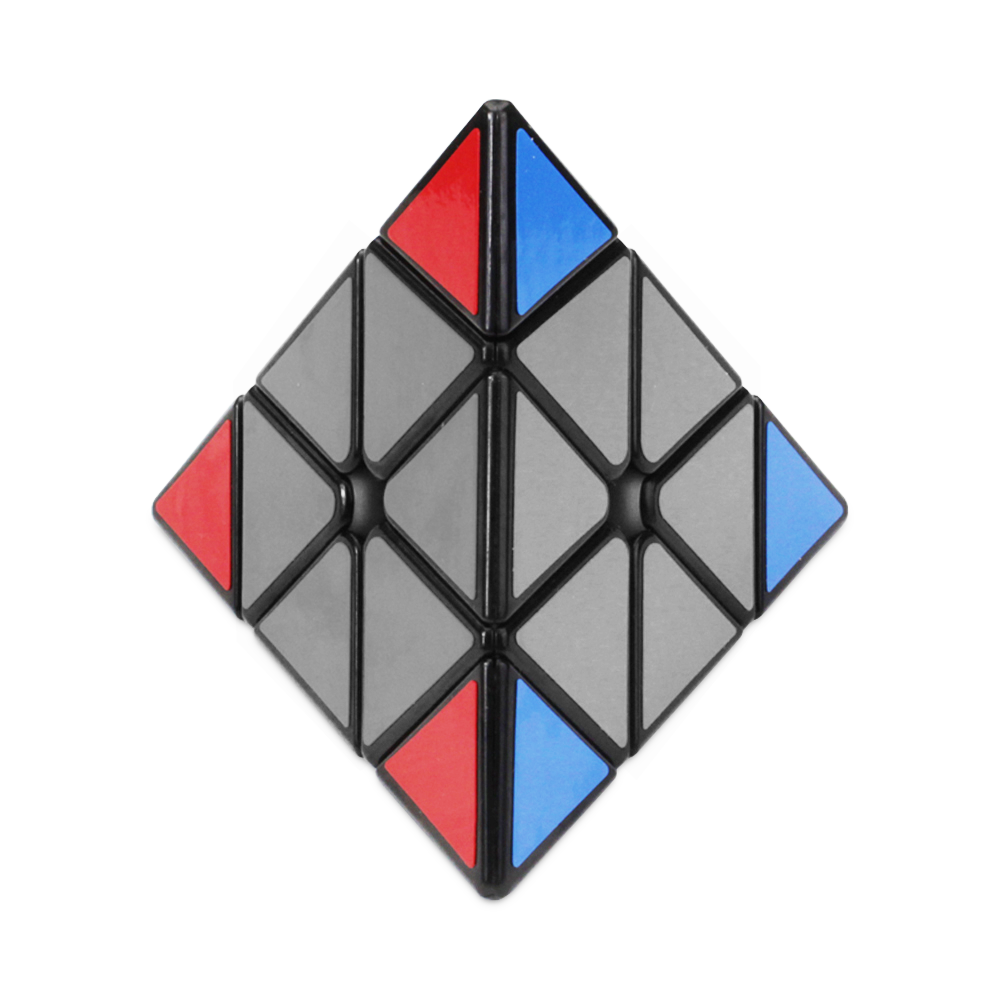
Hardware & Recommendations
Like any event, when performing to the best of your ability it helps to be solving on a good quality puzzle, when using my original Shengshou pyraminx, it's so difficult to get any times below 5 seconds.
Now, I've upgraded to the X-Man Bell Magnetic Pyraminx, as it has stronger magnets than the Moyu Magnetic Pyraminx so I am able to turn fast while maintaining stability; I do also however highly recommend the Moyu Magnetic Pyraminx as it has a much smoother feel than the X-Man Bell. In my Pyraminx I use a medium weight lube (such as weight-3 or SCS Nebula) to make it slightly faster and give it a slightly smoother feel. Overall, these are (as of early 2019) regarded by most as the 2 best Pyraminx puzzles available and I recommend that you try both of these puzzles (most likely at a competition) and see which you prefer.
Methods
There are 2 general methods for solving the Pyraminx, V-First - where you solve a layer except an edge before finishing the puzzle, and Top-First - where you solve the top part of puzzle before solving the rest. Neither method is ‘better’ than the other, however I prefer to use V-First when solving as I find it much more intuitive and easier to understand than the Top-First method. Therefore in this guide I will be giving tips on more advanced V-First solving techniques (as well as more general advice).

This guide is a summary of tips and advice that I hope will help you in the improvement of your Pyraminx solves. I will be primarily cover L4E solving as when reading this guide you should already have decent knowledge of LBL solving.
L4E (Last 4 Edges) is an advanced ‘V’-first method used primarily for sub-5 solving and beyond. Instead of making a full layer as one would in the LBL (Layer By Layer) method; L4E consists of making a ‘V’ (layer minus one edge) before using an intuitive (or learnt) algorithm to solve the remaining 4 edges - hence the method’s name. This method has much more ‘potential for speed’ than the LBL method as when only looking for a ‘V’ during inspection as opposed to an entire layer; one is able to look ahead and influence on the L4E case, giving more opportunity for a smoother and more advance solve.
Making your 'V'
Making a ‘V’ is much simpler than making a full layer as one less edge is required; however similarly to a layer, the 3 centers needed for a layer must also be oriented to create the ‘V’. Unlike basic layers and Vs when one would most likely orient these centers (to create the ‘radioactive sign’), before inserting the 2 edges needed to make a ‘V’ - more advanced solvers would take advantage of this and insert their required edges whilst orienting the required centers, performing the 2 steps in one motion, most likely seen in inspection.
Speaking of inspection… Using inspection time is essential for an efficient solve as it allows one to plan ahead into the solve and predict how the last 4 edges will be solved. It also allows one to plan out how they can perform the necessary moves efficiently, with minimal ‘fuss’, lockup and rotations. This is similar to 3x3, in which one will attempt to avoid unnecessary regrips and awkward turns such as ‘B’ moves.
With an easier scramble and a bit of skilled look-ahead, one-looking the solve may be possible.
The 4 Tips
The way in which the Pyraminx’s tips are scrambled can alter the solve a great deal. A no-tip scramble is obviously going to be much nicer than a 4-tip scramble, as there is less of the puzzle to solve. However the most common scenario is 2-3 tips, so unless you have a lucky set of scrambles, they are going to play a key role in your solves. I would recommend that during inspection; as well as looking for your ‘V’ and L4E possibilities, you should be looking at how you are going to solve the tips. A common mistake is to solve all the tips at the end, this wastes time looking for how to solve them, time that can be used during inspection instead.

However it is still inefficient to solve them all at the start, so I personally recommend that during practice (better untimed) you experiment with solving tips. I recommend solving a couple (depending on how many there are to solve) during your ‘V’, as well as knowing the direction of any remaining tips so they can be quickly solve after L4E - completing the solve. Another good way to practice tip solving is to do a lot of 4-tip scrambles, this will help you not to become overwhelmed by a bad scramble in the future.
Colour Neutrality
In 3x3 solving, when there is generally not too much difference between cross difficulty, colour neutrality is of much less importance. However due to the Pyraminx being a much simpler puzzle, this factor is multiplied, meaning there can be great difference on the solve’s difficulty depending on the colour of which you make your ‘V’ on.
Achieving colour neutrality is a lot easier to do on the Pyraminx as you may already have it with LBL, if not it only takes some practice solves on all four colours before you will know it like second nature!

Finger Tricks
The pyraminx can be awkward to turn and therefore achieving high TPS can be difficult, however improving pyraminx TPS (turns per second) is mostly down to getting used to the shape; and adapting muscle memory; this as well as most aspects of improving one’s solves just comes down to practice.
Most of my turns are done by using my fingers to hold the puzzle; and turning with my wrists, especially with the ‘L’ and ‘R’ layers. Using one’s thumb can come in quite handy as well, especially in adjusting the ‘U’ layer when completing the solve. Most of the faster speed solvers use this method of turning to reach un-thinkable times.
L4E
Things to look for during inspection:
- Solved edges
- Edge in the empty slot (where the third edge would be if one was making a layer)
- Edges off by a sledgehammer
- Position of third-layer edge
Solving L4E:
I typically solve L4E in one of 4 ways:
- Sledge and insert edge
- Insert edge
- Reduce to 2 flipped edges
- Solve back edge and insert final edge
There is a vast collection of YouTube tutorials on specific L4E cases, however, the way I solve is intuitive (no algorithms), I personally recommend this as it gives you a much better understanding of the puzzle then learning algorithms would, you are also able to come up with your own ways of solving L4E that work best for you. So I recommend that you spend a while playing around with the Pyraminx and finding ways of how to solve more efficiently, as you progress in doing this you will learn more about the puzzle and how it works and with the practice of this and TPS you will be able to improve your times drastically!
I hope this guide will help you with your Pyraminx solving.
Good luck and all the best!
Helpful Resources
‘V’ Block Building (Aidan Costello): https://www.youtube.com/watch?v=6C5aul-coWA
Walkthrough Solves (Daniel Goodman): https://www.youtube.com/watch?v=MvYi16F-J4A



















